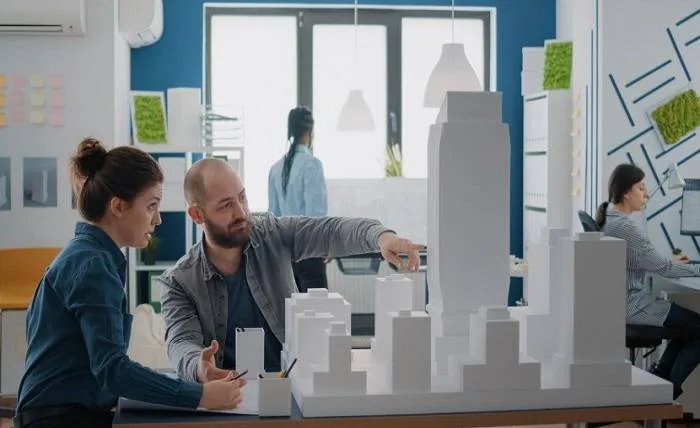BIM is like creating a digital picture of a building, with all the details about walls, windows, pipes, etc. This digital model helps everyone in the project like engineers and architects working together. BIM makes the efficiency and effectiveness of the construction steps.
It is a digital model of a 3D blueprint with all the details. This can be used throughout the entire building procedure from planning and design to construction and maintenance.
It makes project planning, design, and execution easy. It brings the stakeholders together so that they can create better buildings and infrastructure. for construction industry it offers ways to save money on projects. It defines the ways to build things faster, better and make fewer mistakes. BIM is a transformative methodology which empowers architects to create smarter and efficient designs.
Even as technology changes, BIM is still an important tool used by architects to design beautiful and functional buildings. It helps them consider both how the building will look and how it will work.
Advantages of using BIM
- Catch problems: Problems can be identified and fixed before the start of construction.
- Effective communication: Everyone working on the project can see and make changes to the model through communication and collaboration.
- Prevention of mistakes: There are fewer chances of mistakes during construction because the model is so detailed.
- More efficient construction: The model can be used to plan and schedule construction activities more efficiently.
- Connected BIM: The future of BIM involves using cloud technology. “Connected BIM approach,” increases collaboration and connectivity during the architectural process.
- Material optimization: The model optimizes material use, which can reduce waste.
Designing Drafting Services
Designing and drafting services are like digital builders who translate your ideas and the BIM model into clear, 2D blueprints (drawings) that everyone involved in construction can understand. These precise plans ensure everyone is on the same page, preventing confusion during construction.
Building your dream: Made easier with BIM and Drafting
BIM design and drafting services offer to bring your dream on paper in a 3D world!
It’s like a digital model of your building, filled with details about walls, windows, pipes, and even furniture.
Benefits of BIM Design
- See before you build: Explore your building virtually before it’s constructed.
- Smoother communication: Architects and engineers can see the model, making communication better.
- Mistake prevention: All problems can be identified in the design phase. Thus costly mistakes during construction can be avoided.
- Smarter design: Meet building codes more easily to design buildings that are more energy-efficient.
- Easy management: Even after construction, the BIM model is helpful for maintenance and future renovations.
Who uses BIM and Drafting Services?
- Architects: They use BIM to design and develop detailed plans.
- Engineers: They use BIM to ensure the building is structurally sound and functions well.
- Contractors and builders: They use the BIM model and drawings to plan, estimate costs, and build accurately.
- Anyone with a building project: No matter your design experience, these services can help turn your vision into reality.
CAD Drafter
CAD drafters create detailed 2D or 3D models. These models represent objects, buildings, or components.
The drafters ensure that their drawings meet engineering standards and specifications. They add essential details like dimensions, materials, and annotations.
CAD drafters show proficiency in CAD software. They are good at understanding drafting principles and conventions.
Here’s what a CAD drafter does:
1. CAD drafters responsibilities:
Translate Ideas into Visuals:
They prepare comprehensible concepts and descriptions of designs.
Create Precise Drawings:
They create precise detailed 2D or 3D drawings.
Ensure Accuracy and Compliance:
They follow industry standards, building codes, and engineering principles.
Collaborate and Communicate:
They review and modify drawings based on feedback and answer technical questions.
Maintain Records:
They track revisions and keep a record of all versions.
2. Skills and Qualifications:
Technical Drafting Principles:
Understanding geometry, drafting symbols, and dimensioning techniques.
CAD Software Proficiency:
Knowing AutoCAD, Revit, or SolidWorks is important. These are popular programs used for creating technical drawings and models.
Communication Skills:
Effective interaction with engineers and stakeholders.
Problem-Solving:
Identifying and addressing design discrepancies.
3. Career Path:
CAD Drafters find jobs in various fields:
- Architecture
- Engineering (civil, mechanical, electrical)
- Construction
- Manufacturing
- Product design
Masonry estimating service
Companies or experts provide masonry estimating service. They accurately estimate the cost of materials and installation for masonry work in construction projects. Contractors, architects, and engineers use masonry estimating services.
1. Site Visits:
These professionals visit the project site to assess the work scope, identify challenges, and understand the specific masonry requirements.
2. Cost Estimates:
They estimate for the entire masonry project.
3. Value Engineering:
They explore ways to reduce costs without compromising quality or safety. This might involve alternative materials or optimized usage.
Benefits of using masonry estimating service:
- Accuracy: Experienced estimators ensure accurate budgeting, avoiding overruns and delays. They consider factors like building complexity and local labor rates.
- Expertise: These professionals navigate masonry complexities, ensuring realistic estimates.
- Time-Saving: Outsourcing estimation frees up resources for other project aspects.
BIM improves project timelines:
1.Reduced Delays and Improved Efficiency:
a. Clash Detection:
BIM helps identify and resolve clashes between different disciplines like architecture and engineering early in the design phase. This prevents costly rework and delays during construction.
b. Improved Communication and Collaboration:
BIM provides a central model accessible to all stakeholders, making communication seamless. Faster decision-making and fewer delays due to miscommunication result.
c. 4D BIM:
Advanced BIM application integrates time into the model. It identifies bottlenecks and optimizes schedules for faster completion.
2. Studies and Examples:
-
- Research indicates that BIM can potentially reduce work time by up to 50% and deliver cost savings.
- Real-world examples demonstrate successful project completion under budget and ahead of schedule using BIM.
3. Important Considerations:
-
- BIM adoption requires an initial investment in software and training.
- Success depends on proper planning, user expertise, and collaboration among stakeholders.
Conclusion:
BIM creates a comprehensive digital model of a building with intricate details This 3D blueprint serves as a centralized reference for engineers and architects.
From initial planning to construction and maintenance, BIM streamlines the entire building process. It facilitates project planning, design, and execution. Architects can collaborate seamlessly. It allows teams to catch and rectify problems before construction begins. It optimizes material usage, minimizing waste.
BIM helps prevent costly mistakes during construction by identifying and addressing issues early, All project participants can view and modify the model, enhancing collaboration. Detailed BIM models reduce the likelihood of errors during construction. The model aids in planning and scheduling construction activities.
The future involves leveraging cloud technology for enhanced collaboration during the architectural process.
Despite evolving technology, BIM remains a crucial tool for architects. It enables them to consider both aesthetics and functionality, ensuring beautiful yet practical designs.
BIM is not just a tool; it’s a transformative methodology empowering architects to create smarter, efficient structures.



